


The TRACE images may be used without restrictions
in publications of any kind. We
appreciate an acknowledgement indicating that
the Transition Region and Coronal Explorer, TRACE,
is a mission of the Stanford-Lockheed Institute for Space
Research, and part of the NASA Small Explorer program. More information on
TRACE and other TRACE images can be found
here.

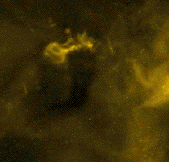 |
On 11-Nov-2008, TRACE was observing a small active region on the Sun,
as you can see in this
[3.1MB QT-mpeg4] movie.
However, outside of the bright region,
an even smaller structure provided some activity. Note the sudden
"coronal dimming" as the small assemblage of magnetic arches
rearranges its surroundings, reminiscent of much larger-scale dimmings
associated with many coronal mass ejections. Courtesy of
David McKenzie (MSU).
 |
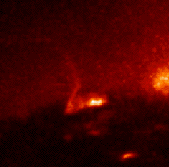 |
This short movie,
taken from TRACE observations on 2008/10/23 in
the 171Å channel, shows two 'jets' inside the large coronal
hole covering the solaar north-polar regions. Jets like these
form when a small bipolar region emerges into a fairly uniform
and nearly radial field inside the coronal hole - i.e., a sign
of continued small-scale flux emergence at high latitudes even
at times of cycle minimum. Courtesy of Steve Saar (SAO).
 |
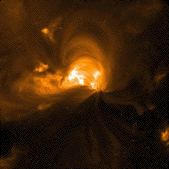 |
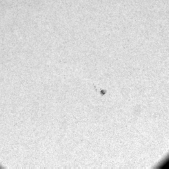
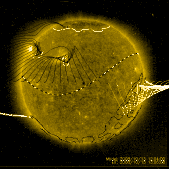
With the Sun in a long-lasting sunspot minimum, only very few new-cycle regions show up. This region, AR 11005, was observed by TRACE in its 195Å (left) and visible-light (center) passbands on 2008/10/14 around 03 UT. The small spot and pores faded away by the end of 2008/10/16, although the coronal brightening endured. The 195Å image on the left is relatively dark on the southern side of the active region, particularly for the field emanating from the small spot group. This is consistent with a model field (based on the PFSS concept), shown in the image on the right: this image shows an open-field region (or coronal hole) associated with the spot group, with (black) field lines reaching into the solar ecliptic to form the interplanetary magnetic field. TRACE images courtesy of Aki Takeda and David McKenzie (MSU);
full-Sun with PFSS ovelay from the LMSAL
forecast site.
|
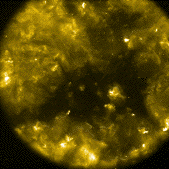 |
Deep in its cycle minimum, the Sun still displays low-latitude
coronal holes. This one, observed on 2008/09/30 at 05:45:01 UT in
TRACE's 171Å channel, even touches on the equator in its
northernmost reaches. Assimilation models show this region to be
the result of several near-equatorial flux emergences near the
equator early in 2008- some of that flux still remains near the
equator because the meridional flow away from it is very slow.
This coronal hole is likely associated with a fast wind stream
in a period of otherwise unusually slow solar wind.
 |
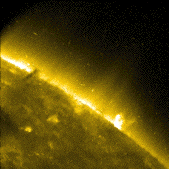 |
Filaments involved in large coronal mass ejections can be a million
kilometers long. And then there are the 'tiny' ones: this TRACE movie
shows a short sequence of 12 frames (showing only 1/4 of the
instrument's field of view) taken in the 171Å passband on
2008/07/21 from 15:20 UT to 15:36 UT (rotated counterclockwise by 90
degrees, with north to the left). Just to the left of the bright
ephemeral region on the limb is a small filament eruption, showing as
a rising dark loop. The separation of its footpoints as measured
against the sky is a 'mere' 13000 km, i.e. about the diameter of the
Earth, but some 75 times smaller than its largest cousins. Data set
suggested by Paolo Grigis (SAO).
 |
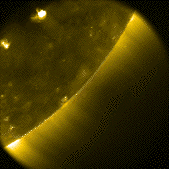 |
With the Sun in a very low state of magnetic activity, there is ample
opportunity to observe the quiet corona. This image, taken by
TRACE on 2008/07/19 at 21:24:46 UT in its 195Å channel, shows the
quiet solar limb. On the disk, we only see the coronal bright points
overlying the ephemeral bipolar regions. High over the solar surface,
the corona consists of a softly glowing haze, but above the limb, we see
thin, nearly-vertical stalks. This reflects the fact that much of this
field connects to distant regions on the Sun, if not to the heliosphere
proper (compare with this
PFSS field model, showing
the magnetic field lines - white, closed; green, open to the heliosphere).
 |
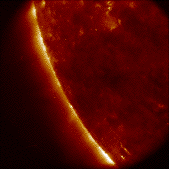 |
The Sun has a cavity. This cavity, however, is not a sign of decay
but of a region under a filament/prominence whose magnetic field is
isolated from the rest of the corona. These regions may look like
coronal holes when they are observed on the Solar disk, but the
similarities are mostly superficial. Both coronal holes and cavities
appear dim in comparison to the rest of the corona due to a density
decrease in both regions. However, it has been shown that cavities
are consistently 2-5 times denser than their coronal hole
counterparts. Coronal holes are regions where magnetic field lines
extend out into space allowing for plasma to stream away from the
Sun. The, cool, dense, filaments that typically lie above cavities
make the magnetic field in these regions quite complex and not well
understood. The magnetic field and temperature structure of cavity
regions may hold clues to the production and eruption of filaments.
The TRACE observations (including this 171Å image taken on 2008/07/03 at
21:27:18 UT) are a part of a coordinated campaign that includes
spectrometers, polarimeters used to measure magnetic fields, and other
imagers. Each instrument provides different clues that help scientists
understand how these features form and evolve. Courtesy of Henry
(Trae) Winter, Montana State University, Solar Physics Group.
 |
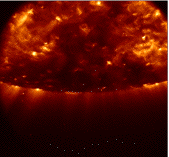 |
Long after the discovery of the outflow of particles from the Sun, or
solar wind, there is still much debate over its source. The solar wind
is known to have regions of different speed and density, the so-called
slow and fast solar wind. Data from the Ulysses spacecraft showed
that the slow solar wind emanates from equatorial, closed magnetic
field regions while the fast solar wind appears to emerge from the
open magnetic field regions of coronal holes. The source and
acceleration of the fast solar wind from these regions is still
unclear. Polar plumes (long lived steady streams of plasma extending
away from the Sun in the image) were initially thought to contribute
to the fast solar wind, but it was discovered that the inter-plume
boundaries are a more likely source, and the plumes themselves may
contribute to the slow solar wind. Activity at coronal hole
boundaries (bright regions around the coronal hole) is another
candidate source for the fast wind. In these regions open field meets
the closed field of the quiet Sun creating an environment for multiple
areas of reconnection that could dump accelerated plasma out along the
open magnetic field lines. Yet another possibility pointed to by
recent observations is that jets (eruptions of fast, hot plasma
triggered by reconnection -- one is seen as a bright dot just to the
right and below the center of the image) are the source of fast solar
wind. Their abundance in number, amount of mass and energy deposited,
and location in open magnetic fields make them good candidates for
fast solar wind production. Sorting among these possibilities will
require more theoretical modeling and observations (e.g. with the soon
to be launched Solar Dynamics Observatory). This image
of the Sun's southern polar regions was taken by TRACE on 2008/06/28 at
00:00 UT in its 171Å channel. Courtesy Samaiyah Farid and Jonathan Slavin
(SAO).
 |
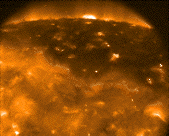 |
By mid-summer of 2008, the Sun continues its rather long quiet state,
characteristic of cycle minimum. In the absence of real active regions,
the thousands of small, so-called ephemeral bipolar regions continue
to maintain a minimal solar activity. These regions are everywhere
embedded within the diffuse glow of the quiet corona, except over the
polar caps, where they stand out brightly within the large coronal holes
that cover these regions in this phase of the solar cycle. This image
shows the ephemeral regions and their coronae over the solar North Pole
on 2008/07709 at 04:58 UT observed by TRACE with its 195Å pass band.
Image courtesy of Dawn Myers (at GSFC).
 |
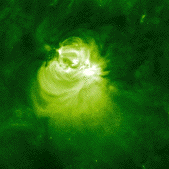 |
With the Sun stubbornly remaining in a state of minimal activity, it offers
ample opportunity to study the continued evolution of fields on the scale
of ephemeral regions (upperleft) and the surrounding so-called quiet Sun.
The quiet Sun regions contain a multitude of small magnetic bipoles and
randomly walking flux concentrations, with loops off all lenght scales
threading the corona above it. This image, taken by TRACE at
2008/06/05 18:05:29 UT in its 171Å channel, shows an area of
quiet-Sun corona, full of small faint loops and darker areas where
there is either little field, or where the field is more of one polarity
leading to longer, fainter connections in the corona above it.
Courtesy Dawn Myers (GSFC).
 |
|
| Home | Mission | Instrument | Team | Operations | Results | Images | Movies | Education | Site Info. | |